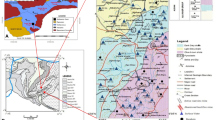Abstract
The functional morphology of kidney cells and the intracellular localization of metal storage sites were studied by electron microscopy and X-ray microanalysis in the Antarctic scallop Adamussium colbecki (Smith) collected at Gerlache Inlet, Terra Nova Bay, Antarctic in December 1990. Kidney cells of A. colbecki show the same basic cytoarchitecture of other Pectinidae, but the nephrolithes localized in the main vacuoles show a low degree of mineralization. The sites of heavy metal storage are: (1) the main vacuole of the renal cell, where Fe, Zn and Cu are associated with concretions, (2) the basal membranes and (3) the lysosomes of amoebocytes, in which Ag, Se, Fe and Cu occur in electron-dense particles. Finally a hypothesis for the formation and role of the Ag−Se rich particles is discussed.
Similar content being viewed by others
Literature cited
Aoi, T., Higuchi, T., Kidokoro, R., Fukumura, R., Yagi, A., Ohguchi, S., Sasa, A., Hayashi, H., Sakamoto, N., Hanaichi, T. (1985). An association of mercury with selenium in inorganic mercury intoxication. Hum. Toxic. 4: 637–642
Bjerregaad, P. (1985). Effect of selenium on cadmium uptake in the shore crab Carcinus maenas (L.) Aquat. Toxic. 7: 177–189
Bryan, G. W. (1973). The occurrence of seasonal variation of trace metals in the scallops Pecten maximus (L) and Chlamys opercularis (L). J. mar. biol. Ass. U.K. 53: 145–166
Bryan, G. W. (1976). Some aspects of heavy metals tolerance in aquatic organisms. In: Lockwood, A. P. M. (ed.) Effects of pollutants on aquatic organisms. Academic Press, London, p. 7–34
Carmichael, N. G., Fowler, B. A. (1981). Cadmium accumulation and toxicity in the kidney of the bay scallop Argopecten irradians. Mar. Biol. 65: 35–43
Carmichael, N. G., Squibb, K. S., Engel, D. V., Fowler, B. A. (1980). Metals in molluscan kidney: uptake and subcellular distribution of 109Cd, 54Mn and 65Zn by the clam Mercenaria mercenaria. Comp. Biochem. Physiol. 65A: 203–206
Chau, Y. K., Wong, P. T. S. (1986). Organic group VI elements in the environment. In Craig, P. J. (ed.) Organometallic compounds in the environment. Longman Publisher, Harlow, England, p. 255–278
Doyle, L. J., Blake, N. J., Woo, C. C., Yevich, P. (1978). Recent biogenic phosphorithe: concretions in mollusc kidneys. Science, N.Y. 199: 1431–1433
Flora, S. J. S., Singh, S., Tandon S. K. (1983). Role of selenium in protection against lead intoxication. Acta pharmac. et tox. 53: 28–32
Fowler, B. A. (1987). Intracellular compartmentation of metals in aquatic organisms: roles in mechanisms of cell injury. Envir. Hlth Perspectives 71: 121–128
George, S. G. (1980). Correlation of metal accumulation in mussels with the mechanisms of uptake, metabolism and detoxication. A review. Thalassia jugosl. 16: 347–365
George, S. G., Pirie, B. J. S., Calabrese, A., Nelson, D. A. (1986). Biochemical and ultrastructural observations of long-term silver accumulation in the mussel Mytilus edulis. Mar. envirl. Res. 18: 225–265
George, S. G., Pirie, B. J. S., Cheyne, A. R., Coombs, T. L., Grant, P. T. (1978). Detoxification of metals by marine bivalves: an ultrastructural study of the compartmentation of copper and zinc in the oyster Ostrea edulis Mar. Biol. 45: 147–156
Leonzio, C., Focardi, S., Bacci, E. (1982). Complementary accumulation of selenium and mercury in fish muscle. Sci. total Envir. 24: 249–254
Lucas, A., Hignette, M. (1983). Les concrétions rénales chez les bivalves marins: études anciennes et récents. Haliotis, Paris 13: 99–113
Magos, L., Webb, M. (1980). The interactions of selenium with cadmium and mercury. CRC. Critical Rev. Toxic. 8: 1–42
Martoja, J., Bouquegneau, M., Truchet, M., Martoja, R. (1985). Recherche de l'argent chez quelques mollusques marins, dulcicoles et terrestres. Formes chimiques et localisation histologique. Vie Milieu 35: 1–13
Martoja, R., Dufranchais, C. B., Jeantet, A. Y., Gouzerh, P., Amiard, J. C., Amiard-Triquet, C., Berthet, B., Baud, J. P. (1988). Effects chimiques et cytologiques de la contamination expérimentale de l'huitre Crassostrea gigas Thumberg par l'argent administré sous forme dissoute et par voie alimentaire. Can. J. Fish aquat. Science 45: 1827–1841
Martoja, R., Viale, D. (1977). Accumulation de granules de séléniure mercurique dans le foie d'odontocètes (Mammiferes, Cétacés): un mécanisme possible de détoxication du méthylmercure par le sélénium. C.r. hebd. Séanc. Acad. Sci., Paris 285: 109–115
Matuk, Y., Ghosh, M., McCulloch, C. (1981). Distribution of silver in the eyes and plasma proteins of the albino rats. Can. J. Ophthalmol. 16: 145–150
Mauri, M., Orlando, E (1982). Experimental study on renal concretions in the wedge shell Donax trunculus L. J. exp. mar. Biol. Ecol. 63: 47–57
Mauri, M., Orlando, E., Nigro, M., Regoli, F. (1990). Heavy metals in the Antarctic scallop Adamussium colbecki. Mar. Ecol. Prog. Ser. 67: 27–33
Pelletier, E. (1985). Mercury-selenium interactions in aquatic organisms: a review. Mar. envirl. Res. 18: 111–132
Rungby, J., Danscher, G. (1983). Localization of exogenous silver in brain and spinal cord of silver exposed rats. Acta Neuropathol 60: 92–108
Shirabe, T., Eto, K., Takeuchi, T. (1979). Identification of mercury in the brain of minamata desease victims by electron microscopic X-Ray microanalysis. Neurotoxicology 1: 349–357
Simkiss, K. (1976). Intracellular and extracellular routes in biomineralization. In: Ducan, J. C. (ed.) Calcium in biological systems, Vol. 30. Symp. Soc. exp. Biol. University Press, Cambridge, p. 423–444
Simkiss, K. (1977). Biomineralization and detoxication. Calcif. Tissue Res. 44: 199–200
Simkiss, K., Jenkins, K. G. A., McLellan, J., Wheeler, E. (1982). Methods of metal incorporation into intracellular granules. Experientia 38: 333–334
Simkiss, K., Mason, A. Z. (1983). Metal ions: metabolic and toxic effects. In: Hochachka, P. W. (ed.) The mollusca, Vol. 2. Environmental biochemistry and physiology. Academic Press Inc., London, p. 101–164
Stockton, W. L. (1984). The biology and ecology of the epifaunal scallop Adamussium colbecki on the west side of McMurdo sound, Antarctica. Mar. Biol. 78: 171–178
Author information
Authors and Affiliations
Additional information
Communicated by O. Kinne, Oldendorf/Luhe
Rights and permissions
About this article
Cite this article
Nigro, M., Orlando, E. & Regoli, F. Ultrastructural localization of metal binding sites in the kidney of the Antarctic scallop Adamussium colbecki . Marine Biology 113, 637–643 (1992). https://doi.org/10.1007/BF00349707
Accepted:
Issue Date:
DOI: https://doi.org/10.1007/BF00349707




